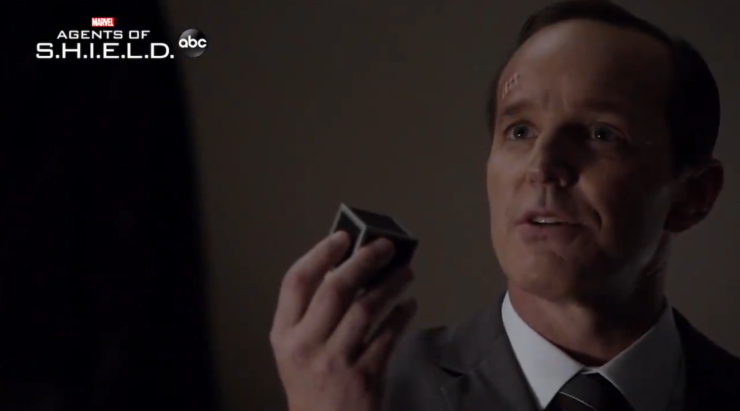The Agents of S.H.I.E.L.D. have reached the end of their final season—a season which involved them traveling through time, visiting key moments in S.H.I.E.L.D. history, and as always, saving the world from destruction. The two-hour grand finale featured all the ingredients of previous season-ending episodes, including evil aliens, setbacks, tricky plots and counterplots, big fight scenes, and clever quips. It also had a much bigger budget for special effects, a cast and crew that have honed their skills for seven seasons, and writers that were more than happy to give the fans a happy ending. This was a show determined to go out on the top of its game!
[Only Agents who are cleared to observe SPOILERS should proceed beyond this point! You have been warned!]
Last night’s installment marked the end of the seventh and final season of Marvel’s Agents of S.H.I.E.L.D.. The series was the last surviving product of Marvel Television, a unit now disbanded and merged into the larger Marvel Studios organization. The show has been run by Jed Whedon, Maurissa Tancharoen, and Jeffrey Bell. Seven seasons is quite a milestone, especially in this era where the television segment of the entertainment industry is in such turmoil. Agents of S.H.I.E.L.D. has survived a lot of ups and downs, and escaped possible cancellation several times, and at this point the dedication of the creators, crew and actors is quite apparent. Budgets have been tight, especially in later seasons, and if you looked closely, you could see lighting, paint, props, and set dressing used in creative ways to repurpose a limited number of sets. But despite these constraints, the storytelling and acting has been top-notch, and the final product always entertaining.
The Story So Far
If you want to refresh your memory on the show’s history, I provided a quick review of Seasons One through Six in my review of the season opener (which you can find here). Season Seven began with the team on the Zephyr, finding themselves unstuck in time, back in 1931 New York. The Chronicom aliens wanted to take over the Earth, and needed to erase S.H.I.E.L.D. from history to do so. Fitz was mysteriously working behind the scenes, leaving Simmons and Enoch to guide the team through their time jumps. Needing an expert on the history of S.H.I.E.L.D., they re-created Coulson as a Life Model Decoy. They saw the origins of both S.H.I.E.L.D. and Hydra in the 1930s, visited Area 51 to thwart Chronicom aliens in 1955, headed off an early version of Hydra’s Project Insight in the 1970s, defeated a Chronicom robot invasion in the 1980s, and battled the evil Nathaniel Malick (of the Hydra-creating Malick family) in the Afterlife Inhuman enclave.
The show has not only been entertaining—it has been a veritable greatest hits compilation of S.H.I.E.L.D.’s history. Now, in addition to Nathaniel Malick, the team faces the evil Chronicom oracle Sibyl, a whole fleet of Chronicom warships, a lost half-sister of Daisy’s named Kora, and a young version of the S.H.I.E.L.D./Hydra double agent John Garrett. Furthermore, the Chronicoms have just blown up every S.H.I.E.L.D. facility in the world, except the bomb-proof Lighthouse. They are now firmly in an alternate timeline, so there is no MCU continuity to worry about, and no constraints on how much mayhem can occur as the team once again races to save the world.
What I’ve Liked Best About the Series
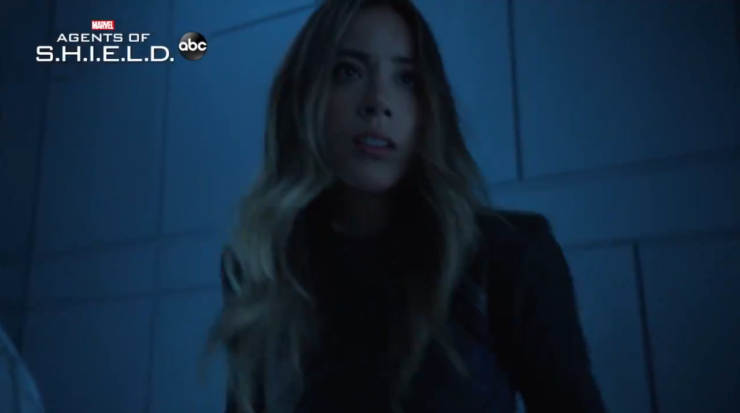
The end of a series always causes fans to look back at their favorite aspects of a show, and the moments that stand out in their memories. From its start, Agents of S.H.I.E.L.D. was a show rooted in characters that seemed like real people, and their reactions to a world full of superheroes and super threats. In the Marvel Cinematic Universe, Agent Coulson was the everyman dragged from his desk to deal with the improbable. His death in the first Avengers movie gave the new team its “Why We Fight” moment, and spurred a fond response from fans rallying around the hashtag #coulsonlives. And over seven seasons of television, we saw this dedicated everyman, without any superpowers other than his intelligence, grit and determination, sacrifice everything to serve his organization’s ideals and protect the planet he called home.
Agents of S.H.I.E.L.D., for all of its science-fictional and superpowered elements, was also rooted in the real and diverse world we live in—something that has been a strength of Marvel comic books for years. Beneath the masks, heroes are shown to be human like the rest of us; they have recognizable, relatable experiences, and friends, families, and personal issues that give their stories depth. The original comic book Nick Fury, who was asked to lead S.H.I.E.L.D. in Strange Tales #135, was simply an enlisted man in World War II who rose through the ranks to Colonel, retired and joined the CIA, and then in 1965 was tapped to run this new high tech, super-secret agency—something that constantly amazed him.
Buy the Book
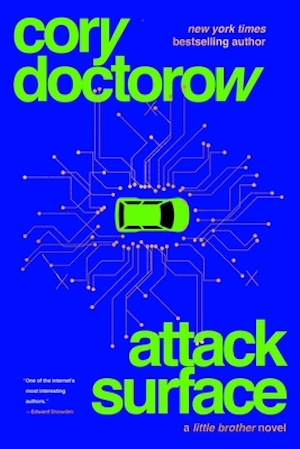

Attack Surface
On the TV show, the agents had past lives, lost loves, significant others, and families who played into the narrative. Among many others, we got to meet Coulson’s lost girlfriend, both May’s ex-husband and her father, Ward’s brother and his mentor, Mack’s brother, and Daisy’s parents. Agent Triplett had a grandfather who served with the Howling Commandoes, and used inherited gadgets to help the team. Agents Hunter and Morse were a divorced couple whose messy relationship often complicated their actions. Sometimes there were superhero elements to these stories, while other times we just got glimpses of ordinary people caught up in an extraordinary world.
The diversity of characters in the show has been another of its strengths. Agent Ward, the dashing young white, male hero who might have easily been the center of another show, defied expectations by turning out to be a despicable double agent. The role of mentor, which might have been filled by a grizzled old macho veteran in a different type of military show or movie, was filled by an Asian-American woman, Agent May. The idealistic hacker, Skye, who joined the team under her birth name Daisy, was also an Asian-American woman. The science team consisted of a young man and woman, Agents Fitz and Simmons, not the bespectacled, elderly oracle we would see in shows of an earlier era. Agent “Yo-Yo” Rodriguez was a Columbian immigrant. And Mack, an African-American agent who worked his way up through the ranks from mechanic to the position of Director, increasingly represented the viewpoint of the relatable everyman in the show, with his love of horror movies often informing his response to unusual events, and especially to robot invaders.
The team became closer as the show progressed, and I think the feeling that they were a family was my favorite aspect of the show. The behind-the-scenes camaraderie that is apparent in cast interviews shone through in the fictional adventures as well. This was a group of people that cared about each other, and took care of each other. And over the last seven years, I, along with many other viewers, came to care for them as well.
Episodes 712 and 713: “The End is at Hand/What We’re Fighting For”
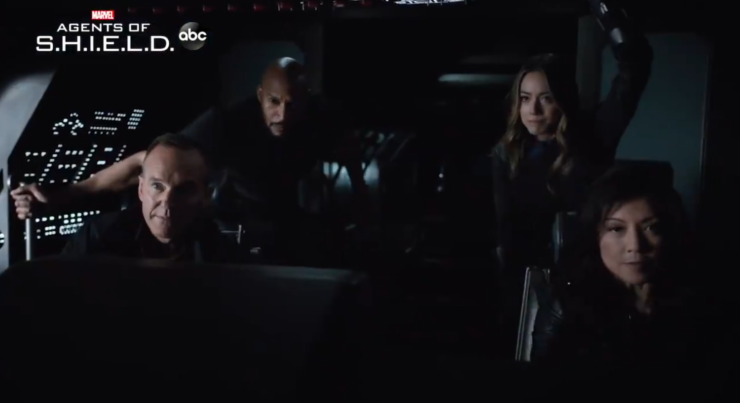
For the grand finale, the network aired the final two episodes back to back, a two-hour event. The network announcement for the episode teased viewers with the question, “The End … or the Beginning?” It stated that Iain De Caestecker (Fitz) would return for the final mission, and promised that fan favorites Briana Venskus (Agent Piper), Maximilian Osinski (Agent Davis), Coy Stewart (Flint), and Joel Stoffer (Enoch) would make special appearances. And it provided this preview of the action: “With their backs against the wall and Nathaniel and Sibyl edging ever closer to eliminating S.H.I.E.L.D. from the history books, the agents must rely on their strengths to outsmart and outlast the Chronicoms. This is their most important fight, and it will take the help of friends and teammates, past and present, to survive…”
The episode begins with Mack, Daisy, and Souza on a mission to rescue Simmons and Deke from Nathaniel. He is with Daisy’s sister Kora on the Chronicom fleet. Sibyl, the Chronicom leader, wants Simmons to remember the location of Fitz, who is the only factor that can prevent Chronicom victory. Nathaniel tries to manipulate Kora, whose mother he has just killed, to kill her half-sister, Daisy. Daisy (after kissing Agent Souza goodbye in the kind of scene shippers live for) rescues Deke and Simmons (whose memory is going haywire). Daisy then confronts Kora, and convinces her to reconsider. Upon learning this, Nathaniel stuns Kora, locks her up, and steals some of her destructive energy powers. The team gets to the Zephyr, and using deactivated Chronicoms that are wired to explode and strapped to their missiles with duct tape (don’t ask…), blast their way out of the Chronicom flagship and head for home.
Intercut with the space scenes while all this action is unfolding, Coulson, May, and Yo-Yo are protecting the Lighthouse. Teleporter Garrett blips in, and plants a dozen bombs. Yo-Yo uses her super speed to gather them all in one place, minimizing the damage. Garrett, who was betrayed by Nathaniel, agrees to work against him. When they get their computers back online, Coulson detects signals from a number of 0-8-4s (remember those McGuffins from Season One?) and has Garrett teleport the team to them. They arrive in the S.H.I.E.L.D. safe house bar in NYC, where several surviving Agents are gathered. They all have cases they were asked to bring, which contain pieces of a device seeded through history by their alien pal Enoch. When assembled by the still-addled Simmons, who has just arrived with the space rescue team, they open a portal to the original timeline, and out pops Fitz!
Fitz has a way to return the team to their own timeline by transiting the “quantum realm” that has appeared in several Marvel movies. But the team also feels a responsibility to this new timeline, and come up with a way to create a bubble so the Zephyr can tow the Chronicom fleet along with them. That requires someone to stay behind to activate the device, but Deke liked this timeline (where he had a rock band that doubled as a secret agent team), so he is glad to remain. The Chronicoms are not dismayed by this, as they don’t care which timeline’s Earth they destroy (and at this point, my understanding of their motivations started getting a bit fuzzy).
Fitz helps Jemma recover her memories, and it turns out that the two of them, aided by Enoch, Agent Piper, and Flint, spent a number of years working on time travel devices to thwart the Chronicoms, figuring out a way to defeat their evil plans altogether. But this plan requires the Inhuman powers of Daisy’s sister, Kora, who they now must rescue. So once again, when they return to the original timeline, one team goes into space to the rescue, while other goes to the Lighthouse to build more devices or something (a rewatch will be required for me to understand all that was transpiring here). Mack, with his trusty shotgun axe, rescues Kora, and Coulson lets himself be captured by Sibyl so that he can watch her key in the control codes. The Coulson and May take out the bridge crew in a big fight scene, while Daisy has an extended battle scene with Nathaniel, who has absorbed not only some of her powers, but some of Kora’s as well.
Using the Chronicom command codes, Fitz’s devices, Kora’s energy powers, and May’s newly emerging empathic powers, the team reprograms the robotic Chronicoms to feel emotions and become friendly (yes, you heard it right: Earth is saved by the power of love). Daisy sacrifices herself to defeat Nathaniel, but the team recovers her body from space, and guess what? Kora’s powers can also be used for healing, and she revives her sister. We also discover that, while Fitz and Simmons were taking years to develop their time travel devices, they also took enough time off from work to have an adorable little girl (presumably so their fans could have all the feels).
The show ends with an epilogue set “one year later.” Yo-Yo is a top field agent (along with Piper and an LMD version of the late Agent Davis). May is an instructor at S.H.I.E.L.D.’s “Coulson Academy,” where Flint is a student. Fitz and Simmons are retired and raising their daughter. Mack is now Director of S.H.I.E.L.D., and has his very own helicarrier. Daisy, Kora, and Agent Souza are exploring the universe as human ambassadors. And LMD Coulson, who is traveling the world, receives a present from the team—a new version of Lola, his beloved red flying car.
It was a nice, warm, happy ending, on top of an episode that was full of action, clever quips, Easter eggs, and key references to events from throughout the show’s history. There was more fan service than any fan might have expected, in the best possible way, and a good time was had by all.
Final Thoughts
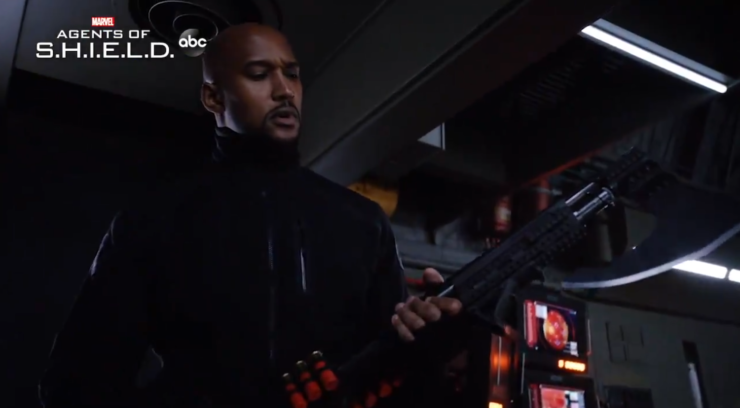
The finale was a slam-bang finish that was very emotionally satisfying, although I must admit some of the “timey-wimey” aspects of the plot will probably not be clear to me until a second viewing. I’ve shared my favorite moments and thoughts on the show with you, and now look forward to hearing from you: What were your favorite moments from the series and the finale? Which quips amused you? What callbacks from previous seasons did you enjoy? And were you happy with where all the agents ended up?
This column has been part of my life for many years. After Chris Lough reviewed the show for the first two seasons, I was given the opportunity to review the show for the remaining five. It was my first job with Tor.com, and I would like to thank everyone at the website for giving me the dream job of reviewing a show based on one of my favorite comic books, as well as all the Tor.com fans who kept coming back to discuss the show episode after episode right until the end.
As always, I’ll end the review with the slogan coined by the late Stan Lee, “Don’t yield, back S.H.I.E.L.D.!”
Alan Brown has been a fan of S.H.I.E.L.D. from its comic book beginning over fifty years ago. He still remembers reading that very first adventure in Strange Tales #135.










